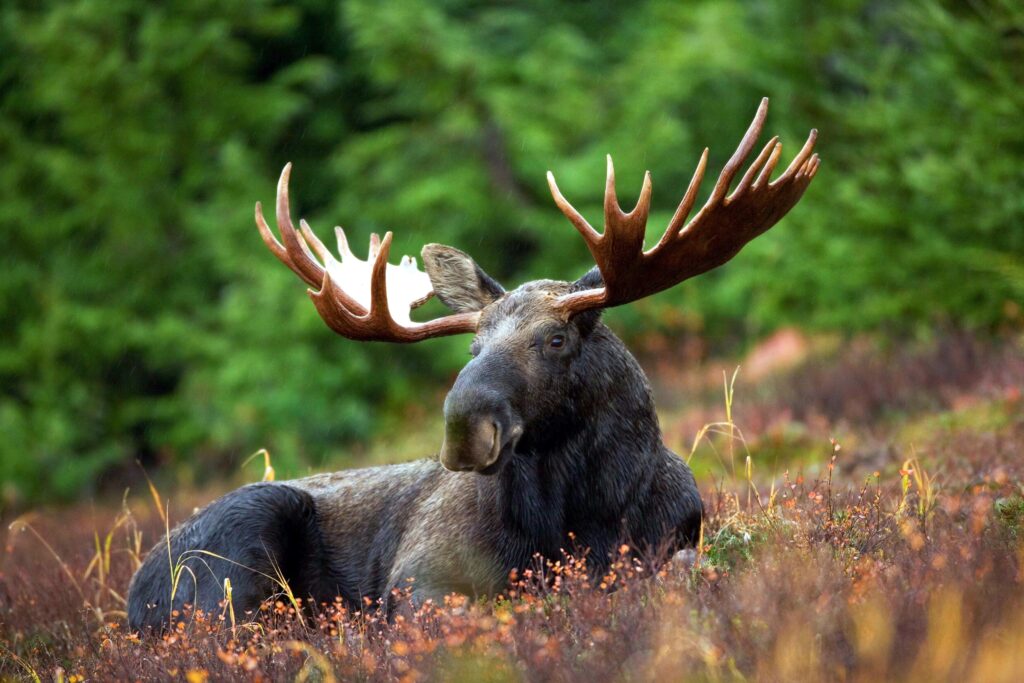We tried to be quiet as we walked through the forest and listen to the sounds of nature. As the leaves crunched, I could hear them over and over again. Then I heard something jump out from behind the trees. Sweden’s wildlife has woken up. As we got closer, a deer quickly ran away. Another time, I was taking my daily walk in the bush with my two cats and my old best friend, a dog. When I looked far away, I saw horns that looked more like tools. I saw a big brown mass staring back at me. That color of his eyes matched the color of his hair. The moose was the king of the forest and stood tall. But just as I took a step, he was gone, hidden by trees. Seeing wildlife in the wild is so amazing! Now, there’s even a moose park that you can venture to in Sweden!
Out in the Wild
There is a lot of wildlife in Sweden because the country has a lot of different types of nature. Ten percent of Sweden is wild, making it the best place for people who love being outside. There are a lot of hiking trails across the country, and nature has so many beautiful spots. You can wander in swampy areas, to taking on the highest mountain, Kebnekaise in Sweden. There are many different kinds of animals that live in the woods. Bears like to stay near water, while moose like to live in woods. Don’t forget to show wild animals respect if you get the chance to see them in the wild. You should stay away from them because they are wild.

1. Reindeer
As they rub their horns against plants, the fur comes off of them. There are a lot of sheep on the road in northern Sweden as we drive to Kebnekaise. It was hours and hours of herds after herds. There aren’t really any wild reindeer. The Sami people raise them and then let them roam freely in Sweden’s northern woods. In Sweden, only the male reindeer have horns, not the females like the red deer or the other deer. They are warmer than other deer and can dig in the snow with their feet. Most calves are born in May or June.
[maxbutton id=”9″ ]


2. Brown Bear
The biggest animal that lives in Sweden is this one. Don’t worry, though; they eat things like berries, ants, plants, and maybe even voles and fish. In the wild, these guys are hard to spot because they are shy. When winter comes, the brown bear goes into hibernation. In the spring, it comes out again. Bear cubs are born in the wild every two to three years. The best time to see the calm animal walking through fields is right before berry season, in May or June. People say that Dalarna, Gavleborg, and Jamtland are the best places for bears to live. This means that these are the most likely places to see the big ball of fur.
3. Wolf
To see a wolf in the wild is a very rare event. Because of this, my husband thought I was lying when I saw a lone wolf. I felt like time had stopped as I looked at the wolf out the window of my car. My coat looked thick. I live outside of town, so nature is all around me. I’m lucky that I get to see a lot of wildlife in Sweden. My husband saw that same wolf one time, and he felt sad for it. He told me that it was very likely that someone would shoot that lone wolf, even though he wasn’t hurting anyone. I didn’t understand until then. People in Sweden have different ideas about wolves. Half of the people love them and think they should be left alone, while the other half think they’re a bother because they keep eating the animals. So, if you don’t want to get into a big fight with a Swedish person, don’t bring up how they feel about wolves while you disagree with them.

Since wolves are social animals, they tend to stay in groups of 10 to 15 and hunt together in the fall and winter. Wolves may hunt alone or with a partner in the summer. Swedish wolves were brought back to the country in the 1980s after being killed to extinction in the 1960s. Hunters could make money off of their warm furs, and keeping them away from land animals helped keep the animals healthy. Sweden has between 300 and 400 wolves.
4. Artic Fox
This beautiful animal lives in hilly and rocky places in northern and northwest Sweden. They are hard to spot in the winter because their coats are so white. One more thing that makes it hard is that they are a threatened species. In Sweden, there are only about 150 of them. The Arctic foxes that live here are protected by the Vindelfjallen Nature Reserve. A lot of the land that they live on can’t be reached by car. It can be hard even when you walk. This pretty animal is also known as the polar fox, the snow fox, or the white fox. The fur on this fox turns a grayish-brown color in the summer. They get their food from lemmings, eggs, dead animals, and berries.


5. Beaver
Rivers and lakes in the middle of Sweden are where you can find beavers most often. Being awake at night and being aware of people can make it hard to see beavers. Watch out for a beaver dam, though, because that’s where they live. In lakes and rivers, these animals build a beaver dam out of tree branches and leaves. They make it their home and fix it up often. If you’re near their dam or house at sunset, you might see a beaver running out of its hole. You can also go by boat to see them. They won’t see you as a threat because they don’t have any enemies in the water. This animal was actually no longer alive. So, Norway brought beavers back to Sweden’s wildlife. That’s why there are about 150,000 beavers.
6. Wild Boar
A lot of people might think of wild boars and big pigs. That’s pretty much what they are. They are known as wild boars and wild pigs. They mostly live in the southern part of Sweden, and Södermanland is a good spot to look for them. These are also a breed of dog that likes to be friends. They like to stay together, and dawn or dusk is the best time to see them. Their groups can have anywhere from 6 to 20 people. You might think that wild boars eat a lot of meat since they can eat anything. In reality, though, 90% of the time they eat veggies and other foods. A group of wild boars can damage crops and trees. But when they mess with the roots, they speed up the soil’s nitrogen cycle.


7. Moose
These huge, beautiful animals live all over Sweden. They are hard to spot, though, because they look so much like trees. Moose hear things better than they see. Shut up as you walk if you want to see them. The best time to see them is in the open during the summer nights. Now is the time when they are looking for food. Another name for these animals in British English is “elk.” In the United States, a “elk” is a different animal. This is Sweden’s largest animal and the king of the forest, the moose. Sweden is home to between 300,000 and 4,000,000 moose. What time of year it is makes no difference.
If you’re interested in learning more about moose and seeing them up close, check out Värmland Moose Park. I have an article where I explain more about the place and what’s in store for a visitor!
8. Lynx
More than any other animal, the lynx is very hard to see. It is the biggest of the four kinds of lynx that live in the world. This animal lives all over Sweden and is the biggest cat in Europe. It’s also the only species of wild cat in the country. For the most part, you can catch a quick glimpse of one in the trees early in the morning. They live in thick woods. There are now over 1,300 lynx, and that number has been going up. They are good shooters and have caught everything from hare to reindeer.


9. Wolverine
This animal is in the same family as otters and badgers, which are called mustelids. It’s not just a figure from a movie or video; the wolverine is a real, dangerous animal. The wolverine is a shy animal that is still in danger in Sweden. The number of these species living in Sweden is thought to be around 450. It’s unlikely that you’ll see a wolverine. But if you really want to try, you should look in the mountains, especially in the winter. Their brown-black hair stands out against the cold ground.
Sweden Wildlife Tours
Have you been wanting to get closer to nature? Do you want to try and catch a glimpse of Sweden wildlife? Then, check out Wildlife Safari in Stockholm. It takes about 4 hours you’ll get to enjoy a beautiful sunset while an expert guides you on a tour to spotting wild animals.
Or check out a 5 hour day trip from Stockholm. In this tour, you get to try a smokey dinner by a campfire. Then after learning about what animals you could possibly see; this tour begins to journey into the wilderness.

Adventures in Sweden
The best places for seeing Sweden wildlife is in the Nature Reserves or on the less traveled paths. Explore some of the areas and get a thrill off of the less known parts of Sweden. There are canoe trips that you can have in several places within Sweden as well! Check out Adventures in Sweden for more!
[maxbutton id=”14″ ]
Pin it on Pinterest!



